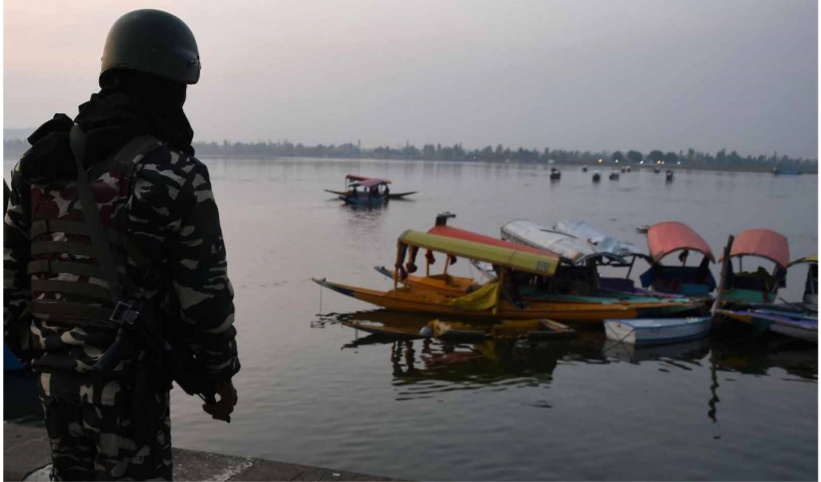New Union Territory Of J&K and Union Territory Of Ladakh come into being

HIGHLIGHTS
• This is for the first time that a state is converted into two UTs even though there are numerous examples of a UT becoming a full state or a state bifurcating into two states
• The new lieutenant governors of the two UTs — G C Murmu in J&K and R K Mathur in Ladakh — will be sworn in at separate ceremonies in Srinagar and Leh, respectively
• The total number of states in the country will now be reduced to 28 while the number of UTs will go up to nine
NEW DELHI: At the stroke of midnight, Jammu & Kashmir ceased to be a state of the Union, making way for two new
Union territories of J&K and Ladakh
This marks an important milestone in the history of J&K and, especially, Kashmir Valley’s tense ties with the rest of the country, and culminates the process which started on August 5 with the landmark announcement for emasculation of
Article 370 as well as end of statehood for J&K.
This also put to an end to J&K’s flag and constitution, symbols of the state’s special status. With October 31 fixed as the appointed day for reorganisation of J&K, the new lieutenant governors of the two UTs — G C Murmu in J&K and R K Mathur in Ladakh — will be sworn in at separate ceremonies in Srinagar and Leh, respectively.
The creation of the UTs of J&K and Ladakh coincides with the birth anniversary of
Sardar Vallabhbhai Patel, credited with the merger of over 560 states with the Indian Union and who has been promoted by the Modi government as the embodiment of national unity and muscular nationalism.
The change in the status of J&K from a state to a UT comes even as there is a fresh spate of targeted attacks in the Valley against non-Kashmiris and “outsiders”, while communication curbs remain in force amid strong indications, sources in the security establishment said, of desperate efforts by Pakistan to incite trouble.
Parliament’s decision of August 5 marked a dramatic turn in the history of the sensitive region, a counter-punch to a defiant clamour for enhanced autonomy and a brutal Pakistan-backed terror campaign. It came against the backdrop of a popular push in the rest of the country for a tough response to terrorism and separatists.
It also represented a powerful break from the way the Centre had dealt with the border state. The old approach sought to blend toughness towards terrorists with promises to enhance autonomy and talks with Pakistan, which made no secret of its determination to grab the Muslim-majority province.
The Modi government changed the terms of engagement with both the separatists and Pakistan. The conversion of the state into two UTs means that politicians in the Valley can, at most, hope for restoration of statehood. The August decision also means that Pakistan will have to try hard to re-establish its locus on J&K as and when the two sides decide to resume negotiations. The steps taken since — the communications lockdown, the defiance of global liberal sensitivities as well as the attempt this week to tap into the growing influence of right-wing globally — represents the resolve to brazen out any unhappiness in global capitals.
The central government has justified its decision to make Article 370 a dead letter in J&K, blaming it for rising violence and militancy in the Valley as unemployed youth are forced to pick up the gun and for denying the people of the state benefits of many central legislations and benefits like SC/ST reservation, right to education, right to information etc.
The decision to end special status for J&K marked fulfilment of BJP’s long-standing agenda and its 2014 poll manifesto promise, and conforms to the “nationalist” view that it would complete J&K’s integration with the Indian Union. This is over 70 years after the then ruler of the princely state of J&K, Maharaja Hari Singh, executed the Instrument of Accession on October 26, 1947, making it part of the Union of India.
This is the first time that a state is being bifurcated into two UTs. In the past, there have been instances of a UT becoming a full state or a state being reorganised into two states.
The total number of states in the country will now be reduced to 28 while the number of UTs will go up to nine.
According to the J&K Reorganisation Act, the UT of J&K will have a legislature, like Puducherry, while Ladakh will be a UT without legislature, like Chandigarh, and both the UTs will be headed by two separate lieutenant governors.
The Centre will be in direct control of police and law & order in J&K from Thursday while land will be under the elected government.
The UT of Ladakh will be under the direct control of the central government which will administer the high altitude region through the LG.
For employees of the state government, including police personnel, the change means a jump in salaries and perks as they, thanks to their new status as central employees, become eligible for pay scales fixed for central employees by the Pay Commission.




